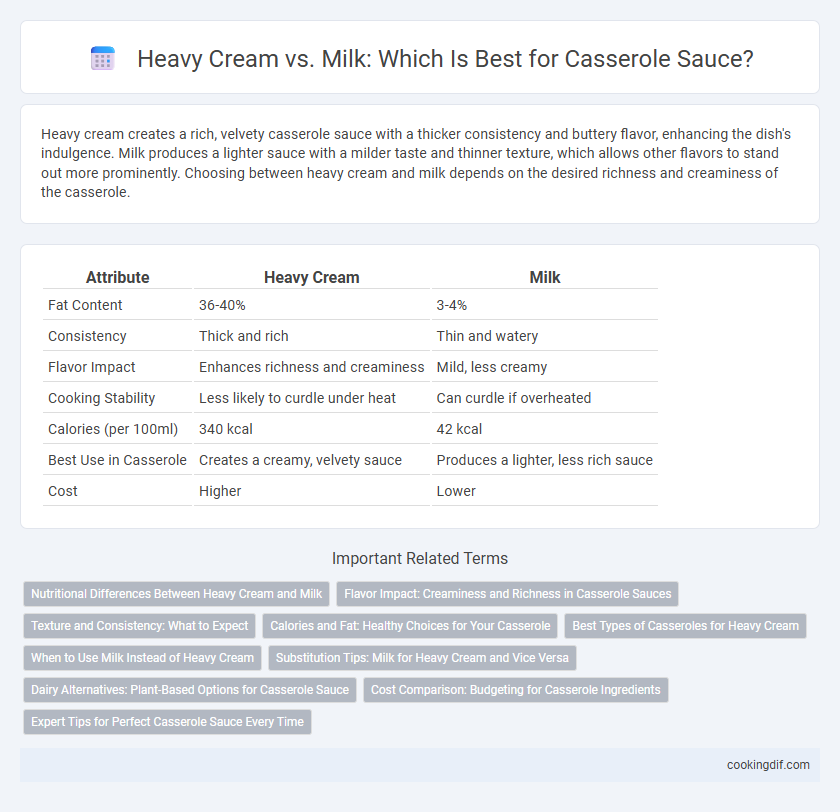Heavy cream creates a rich, velvety casserole sauce with a thicker consistency and buttery flavor, enhancing the dish's indulgence. Milk produces a lighter sauce with a milder taste and thinner texture, which allows other flavors to stand out more prominently. Choosing between heavy cream and milk depends on the desired richness and creaminess of the casserole.
Table of Comparison
| Attribute | Heavy Cream | Milk |
|---|---|---|
| Fat Content | 36-40% | 3-4% |
| Consistency | Thick and rich | Thin and watery |
| Flavor Impact | Enhances richness and creaminess | Mild, less creamy |
| Cooking Stability | Less likely to curdle under heat | Can curdle if overheated |
| Calories (per 100ml) | 340 kcal | 42 kcal |
| Best Use in Casserole | Creates a creamy, velvety sauce | Produces a lighter, less rich sauce |
| Cost | Higher | Lower |
Nutritional Differences Between Heavy Cream and Milk
Heavy cream contains approximately 5 times more fat than milk, providing a richer, creamier texture for casserole sauces but higher calories and saturated fats. Milk offers significantly fewer calories and fats, making it a lighter option with more protein and calcium per serving. Choosing between heavy cream and milk depends on dietary goals and desired sauce consistency in casseroles.
Flavor Impact: Creaminess and Richness in Casserole Sauces
Heavy cream enhances casserole sauces with its superior creaminess and rich texture, creating a more indulgent and luxurious mouthfeel compared to milk. Milk offers a lighter flavor and thinner consistency, resulting in a less dense sauce that can reduce overall richness. Using heavy cream intensifies the savory depth and smoothness, making it ideal for casseroles that benefit from a velvety, full-bodied sauce.
Texture and Consistency: What to Expect
Heavy cream provides a rich, velvety texture and thick consistency to casserole sauces, resulting in a smooth and luxurious mouthfeel. Milk, being thinner and less fat-dense, creates a lighter sauce with a more fluid texture that may not cling as well to ingredients. For casseroles requiring a creamy, stable sauce that holds structure during baking, heavy cream is the preferred choice over milk.
Calories and Fat: Healthy Choices for Your Casserole
Heavy cream contains approximately 800 calories and 88 grams of fat per cup, making it a rich option for casserole sauces that enhances creaminess but significantly increases calorie and fat content. Milk, with around 100 calories and 2.5 grams of fat per cup (for whole milk), offers a lighter alternative that reduces the overall calorie load while still providing some creaminess. Choosing milk over heavy cream can make casseroles healthier by lowering saturated fat intake and supporting weight management goals.
Best Types of Casseroles for Heavy Cream
Heavy cream creates richer, creamier casserole sauces ideal for dishes like chicken and mushroom casseroles or creamy seafood bakes, where its high fat content enhances flavor and texture. Milk-based sauces suit lighter casseroles such as vegetable or tuna bakes, providing a subtle creaminess without overpowering delicate ingredients. Casseroles that benefit most from heavy cream include those with robust, savory fillings requiring a luxurious, velvety sauce to balance hearty components.
When to Use Milk Instead of Heavy Cream
Milk is ideal for casserole sauces when a lighter texture and lower fat content are desired, providing a smooth but less rich consistency. Use milk in recipes that require longer baking times to prevent the sauce from becoming overly thick or heavy. Choosing milk over heavy cream helps reduce calories while maintaining enough creaminess to complement vegetables or lean proteins in casseroles.
Substitution Tips: Milk for Heavy Cream and Vice Versa
Heavy cream provides a rich, velvety texture and higher fat content ideal for creamy casserole sauces, while milk offers a lighter consistency with less fat, making it a healthier but thinner option. To substitute milk for heavy cream in casseroles, mix 3/4 cup milk with 1/4 cup melted butter to approximate the fat content and richness. When using heavy cream instead of milk, dilute it with a small amount of water or broth to reduce thickness and prevent overpowering the casserole's flavors.
Dairy Alternatives: Plant-Based Options for Casserole Sauce
Heavy cream and milk differ significantly in richness and fat content, affecting casserole sauce texture and flavor; plant-based alternatives such as coconut cream and cashew milk provide creamy consistency without dairy. Coconut cream offers a thick, rich base ideal for savory casseroles, while cashew milk delivers a subtle nutty flavor with moderate creaminess. Almond milk and oat milk serve as lighter options, enhancing moisture without overpowering the dish, making them suitable for dairy-free casseroles.
Cost Comparison: Budgeting for Casserole Ingredients
Heavy cream costs significantly more than milk, with prices averaging $4 to $6 per pint compared to milk's $0.80 to $1.50 per quart, impacting overall casserole ingredient budgets. Using milk reduces expenses and offers a lighter sauce, but heavy cream provides richer texture and creaminess, often requiring smaller quantities. For cost-conscious cooking, substituting milk or a milk-cream blend can balance budget constraints and desired casserole sauce flavor.
Expert Tips for Perfect Casserole Sauce Every Time
Heavy cream creates a rich, velvety casserole sauce with a higher fat content that prevents curdling and ensures smooth texture during baking. Milk, while lighter and lower in fat, may require additional thickening agents like flour or cornstarch to achieve a creamy consistency without separation. Expert tips recommend choosing heavy cream for a foolproof, indulgent sauce and gently simmering any milk-based mixture to maintain stability and prevent the sauce from becoming watery.
Heavy cream vs Milk for casserole sauce Infographic

 cookingdif.com
cookingdif.com